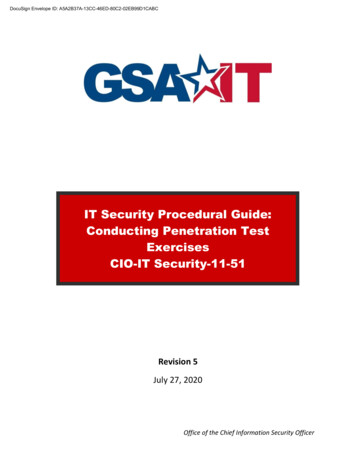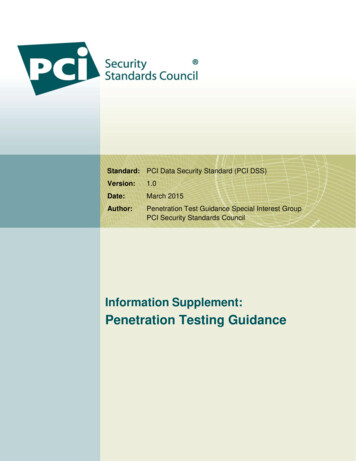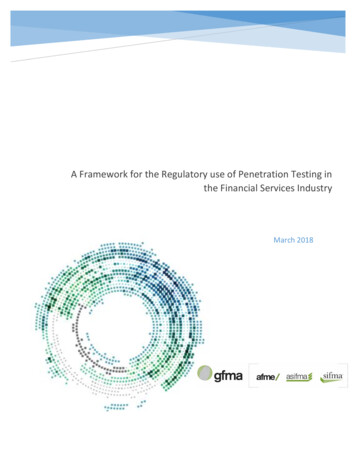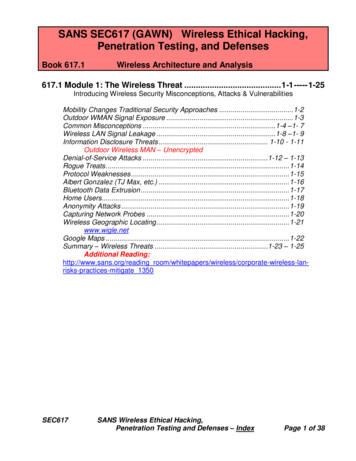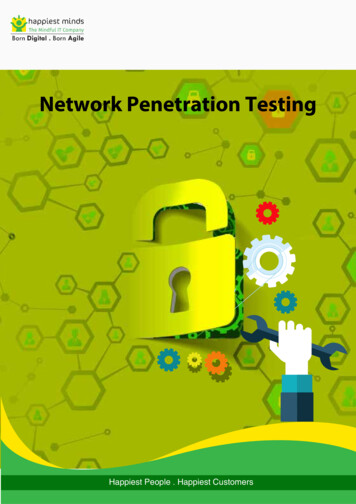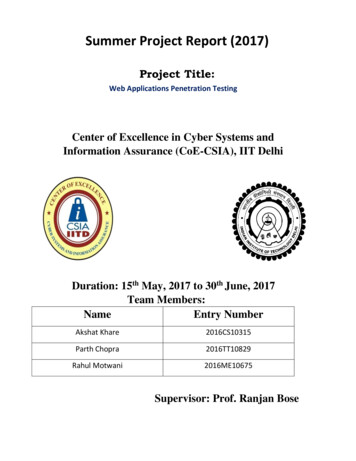
Transcription
Summer Project Report (2017)Project Title:Web Applications Penetration TestingCenter of Excellence in Cyber Systems andInformation Assurance (CoE-CSIA), IIT DelhiDuration: 15th May, 2017 to 30th June, 2017Team Members:NameEntry NumberAkshat Khare2016CS10315Parth Chopra2016TT10829Rahul Motwani2016ME10675Supervisor: Prof. Ranjan Bose
Abstract:What is Penetration Testing?A vulnerability assessment simply identifies and reports noted vulnerabilities, whereaspenetrations test (Pen Test) attempts to exploit the vulnerabilities to determine whetherunauthorized access or other malicious activity is possible. Penetration testing typically includesnetwork penetration testing and application security testing as well as controls and processesaround the networks and applications, and should occur from both outside the network tryingto come in (external testing) and from inside the network.Penetration Testing Execution StandardsPTES defines penetration testing as 7 phases. Pre-engagement Interactions: Includes getting PermissionsIntelligence Gathering: To get the info about the system or application using tools likenmap and whoislookup.Threat ModellingVulnerability Analysis: To find out the vulnerabilities in the system ExploitationPost Exploitation: There should be illegal use of data that a pentester access.Reporting: Proper Step by Step Report should be submitted to client specifying all typesof test that has been done.We will use metasploit tools in Kali-Linux OS to do Penetration Testing. Details have beenmentioned above.Citations: https://www.owasp.org/index.php/Penetration testing etration-testing1
AcknowledgementWe would like to extend our sincere gratitude to Prof. Ranjan Bose to provide us an opportunityto do this project under Center of Excellence in Cyber Systems and Information Assurance, IITDelhi.We also want to thank Mr. Ujjwal Sinha, our project mentor, who guided us to do this projectand helped us with the technical aspects.We also had help from our friends and other team members who made valuable suggestions forthis project. So they made an indirect contribution to this project.We would also like to extend our deepest gratitude to all those who have directly and indirectlyguided us in doing this project.We learnt many things while doing this project. We also learnt how to work in team and coordinate in a team along with the technical skills involved in this project. It motivated us to learnmore in the field of Information Security and pursuing career in this field.2
Table of ContentsS. No.TopicPage No.1.Abstract12.Acknowledgment23.Table of Contents34.Plan of Action4-55.Project report for Week 166.Project report for Week 277.Project report for Week 388.Project report for Week 499.Project report for Week 51010.Project report for Week 611-1911.Project report for Week 72012.Results21-2813.Conclusions293
Plan of Action Week 1 Learning the basics of Ethical Hacking from http://insectechs.usefedora.comLearning how to use virtual machines to provide a suitable platform for learning.Creating sites on local hosts.Google hacking to gather the information about a web application.Understanding different types of malwares like virus, Trojans, Keyloggers etc.Different type of attacks that can be performed on a system or web application.We will cover the major portion of Ethical hacking Module and practice the techniquesthat we will learn Week 2 Completing the Ethical Hacking module of the Master Penetration Course by Insec-Techslabs and surfing the open sources on internet to learn more. By the mid of this week we expect to complete the Ethical Hacking.Learning the basic vulnerabilities in the websites like XSS, CRSF, SQL injection.Installing Kali Linux in live USB mode and configuring it to persistence mode.Learning the metasploiit framework.Learn how to use its methodology to do Penetration Testing of a system.We will practice these attacks on a virtual machine using Kali Linux as attacking OS.We expect to complete major part of Course Penetration Testing using Metasploit.Learning about the exploits, payloads and hoe to use them.Learning about the different interfaces of metasploit like console, cli, armitage etc. Week 3 We will complete the Penetration Testing using Metasploit in the early part of this week We will practice the attacks to acquire skills of a good penetration tester in this week. Learning about more techniques like making an executable backdoor in the victimcomputer and using it to gain access. Learning about the commands used in meterpreter, ranking of exploits etc. Learning about msfpayload, binary payload, exploiting MS Office, making persistencebackdoor, exploiting pdf vulnerabilities etc. Learn how to use beef, webjacking, vielframe etc.4
We will start Web Application Penetration Testing in this week and complete its majorpart. Week 4 Main target is to complete the course Web Application Penetration Testing.Learning client server architecture and protocol status codes.Learning Bypassing client-side controlsLearning about the necessity of Application security.Learning and practicing the attacks on Authentication, Storage Blocks, and ApplicationServer etc. We expect to complete the related courses and have knowledge of pentesting by theend of this week. Week 5 This week we will practice the things we have learned on different machines andoperating systems with permissions. We will also practice pentesting on some Web Application after having properpermissions We will have first-hand experience of pentesting by the end of this week. Week 6 In this week we will demonstrate what we have learned about the Penetration Testingusing metasploit. We will start learning the automated ways of Pentesting the web application. If time permits we will work on the patches that can be used to protect the webapplications from the attacks after finding the vulnerabilities using Penetration testing. Week 7 To perform attacks on the Web-Application. To learn how to make reports. Using some scripts to take advantage of loops in the web-application. To find out how to make the application secure.5
Report for Week 1 (15-05-17 to 20-05-17)Objectives: Learning the basics of Ethical Hacking. Completing the course of Ethical Hacking provided by InsecTechs Lab.Achievements: Our team almost completed the target described in the Plan of Action.We watched the course video and learned a great deal about Ethical Hacking.Created Virtual Machines using VMware.Learned basic Linux and Windows Command lines.Learned about the sites on local host using XAMPP.Leaned about Viruses, Trojans and other malicious programs.Seen the videos regarding vulnerabilities found in Web Applications like SQL Injections,XSS, CSRF and what causes it and how they can be fixed.Learned system hacking, wireless hacking.Learned about proxy servers, VPN, Cryptography, Firewalls etc.We will follow the above given plan of Action in the coming week.6
Report for week 2 (22-05-17 to 27-05-17)Objectives: Completing the Ethical Hacking Module of the course provided by the InsecTechs Labs.Creating a means of using Kali Linux for our team.Learning about the metasploit framework.Learning about the methodology of Penetration Testing.Achievements: We have completed the basic ethical hacking and we now have learnt about system hacking(different type of attacks that can be used to gain unauthorized access and their prevention. We have learnt how to track emails and how to use online tools for information gatheringabout a system or organization. We have learnt how to spoof our IP. We are familiar with different vulnerabilities in the web application. We successfully made a live bootable Kali Linux in a USB. We made it persistent to changes.During this we learnt how to manage disk fragments and how to reuse unallocated space inan USB. One of our team members is using Microsoft Azure account to rent a machine with KaliLinux. We started metasploit framework and learnt the use of exploits like netapi, aurora. There is still some part of the course Penetration Testing using Metasploit left that we hadto complete this week but we will manage to get it done with the targets of next weekcompleted at the end of third week.Target for next week: Completing the remaining target of week 2 and the targets ofweek 3 as given in plan of action.7
Report for Week 3 (29-05-17 to 03-06-17)Objectives: Completing the Penetration Testing with Metasploit of the course provided by theInsecTechs Labs. Getting familiar with Kali Linux for our project.Metasploit framework put to action.Learning about the methodology of Penetration Testing.Working on Beef ModulesWorking on VeilLearning about how to exploit victim using Armitage with VeilAchievements: We have completed the Penetration Testing using Metasploit in this week. Learnt about more techniques like making an executable backdoor in the victimcomputer and using it to gain access. Learnt how to use beef, webjacking, vielframe etc. We have started Web Application Penetration Testing in this week and completed itsmajor part. Learnt how to use Beef. Learnt about how to exploit victim using Armitage with Veil. Learnt how to use Browserbased Exploitation. Worked on Beef and explored its advantages. Exploited victim using Armitage with Veil. Learned how to use Veil framework to avoid Anti Viruses.Target for next week:Completing the remaining target of week 3 and the targets of week 4 as given in plan of action8
Report for Week 4 (05-06-17 to 10-06-17)Objectives: Completing the Web Application Penetration Testing of the course provided by theInsecTechs Labs. Getting familiar with Kali Linux for our project.Metasploit framework put to action.Learning about the methodology of Web Application Penetration Testing.Learn about Client Server ArchitectureLearn Protocols and working with themAchievements: We have completed the Web Application Penetration Testing in this week.Learnt about Client Server Architecture and how to use it in our benefit.Learnt about Protocols and how to work skilfully with them.Learnt about various Offensive and Defensive MechanismsLearnt about Web-DojoLearnt about how to master security with Web-DojoLearnt about core Defence mechanismsLearnt Mapping Web ApplicationsLearnt about how to bypass client-side controlsTarget for next week:Completing the remaining target of week 4 and the targets of week 5 as given in plan of action9
Report for Week 5 (12-06-17 to 17-06-17)Objectives: Completing the Web Application Penetration Testing of the course provided by theInsecTechs Labs. Learn Protocols and working with them. Practising and implementation of various pen tests. Learn about attacking Data Stores and Backend components. Learn attacking Native Compiled Application. Learning and performing OWASP top 10 attacks.Achievements: We have completed our planned course of web application penetration testing on theInsecTech.We have tried OWASP top 10 attacks of the year 2017 and also covered few more attacksover a locally hosted application.This has enabled us to successfully penetrate through web application having poor security.We have also looked on possible methods to counter these attacks from happening byremoving certain vulnerabilities.Learnt attacking Native Compiled ApplicationLearnt attacking Data Stores and Backend components.Gave a live demonstration of SQL Injection and Cross site scripting to our mentor.Target for next week:We will try to master security tests on web hosted applications and also follow plan of actionfor week 6.10
Report for Week 6 (19-06-2017 to 24-06-2017)Objective:Analysis of a Web Application Penetration Testing Report.Achievements:We analysed a Penetration report made by Acumen Innovations for the vulnerabilities andsecurity assessment for the firm Business Solutions and are explaining all of our understanding:They were contracted by Business Solutions in order to conduct a thorough penetration test oftheir public infrastructure and determine what kind of access a malicious attacker could attain.Specifically, Business Solutions was interested in the following: Determining whether an external attacker could find an entry point into the internalnetwork.If a path was found, determine:o What systems the attacker could reacho If the confidentiality/integrity of confidential system information would becompromisedThe attacker was modelled after a regular Internet user with no previous knowledge of thecompany. The only information provided was a domain name, and only the server hosting thisapplication was within the scope of work.Through a series of vulnerabilities, they managed to get past the perimeter defences and intothe server. Further network discovery was done in order to obtain a picture of the networkconfiguration and further the attack.During the internal discovery phase, it was discovered that the breached structure was part ofan internal network which contained multiple devices. They focused their attention on amachine which appeared to be the Human Resources computer.This target was chosen because it seemed likely that it would host confidential informationabout company personnel and was therefore deemed a high value target.Further exploitation of the target system resulted in complete control over the HR computer,along with additional credentials that could be used to further the attack. At this pointhowever, it was determined that enough control had been obtained in order to successfullydemonstrate the seriousness of the vulnerabilities found. The assessment was conducted in acontrolled manner following the recommendations outlined in NIST SP800 -115.11
Narrative:Reconnaissance:Initial view of the targetThe first step of the penetration test was to gather information about our target using thestarting point given, which is the url. The web application was examined for vulnerabilities andport scans were done in order to identify what ports where open and what services wherelistening.The port scan revealed two publicly accessible services running; a web server running on port80 and an ftp server listening on port 21.Nmap indicates the presence of a network level firewall filtering probes to other ports. FTP andWeb servers are both exposed to the public.Service version enumeration was accomplished through banner grabbing and it yielded anapache web server and a proftp server both running outdated versions. Since previous proftpversions contained several vulnerabilities, this was chosen as their target.12
First Phase - Compromise Public ServerAfter studying the ftp application, they discovered two vulnerabilities. The first was a publiclyknown exploit on the mod copy module which enabled unauthenticated users to move fileswithin the server. This enabled them to move the /etc/passwd file, and due to a permissionsmisconfiguration, move the /etc/shadow file as well.Improper file permissions yielded access to the shadow file which containedhashed passwords for company executives.An attempt to crack the hash in the shadow file provided no results, at which point they wentback to carefully study the ftp application and they identified a previously unknownvulnerability.The proftp application did not seem to strip invalid characters from the username parameterbefore recording the login attempt to the access.log file. This enabled them to inject a shortpiece of php which, when executed, would upload a reverse connect shell from their server totarget.The username parameter in Proftp 1.3.5rc3 did not properly sanitize user inputbefore passing it to auth.logUsing the first vulnerability, the log file was moved to the root web folder and renamedupload.php. This way it would be treated as a php script when called, which would execute thepreviously injected php code and upload their shell.A listener was set up and when the file was called we obtained a reverse shell with the privilegeof the www-data user.13
By leveraging a known vulnerability and an unknown vulnerability, a shell was successfullyuploaded into the public server. This allowed us to upload more tools to further the attack.Second Phase – PivotWith an interactive shell on the server they had the permissions of the www-data user. Ratherthan attempt to escalate privileges, they focused on further network discovery and studyingwhat other applications were on the server. Since no developer tools were found on the server,a bash script was uploaded and was used to get more information about the system. Resultsshowed an SQL database and SSH server listening on ports 3306 and 22.Once behind the network firewall, reconnaissance of the server revealed a MySQL database andSSH server running locally.This indicated that a network level firewall was in place which had dropped their previous scansto those ports. During the scan, a Windows machine was identified using the open and closedports, as well as NetBIOS. Enumeration revealed a wealth of information, such as the machinehaving shared folders, computer name and more. This was chosen as their target as the nameindicated it would be a high value target.14
Ascan done from the compromised system revealed it was part of an internal network, and weused it as our pivot to enumerate the internal environment. The system located at192.168.255.3 had a telnet server, NetBios, remote desktop, and more listening services.The computer name indicated that this machine belonged to a human resources staff member,which made it a valuable target due to confidential files stored within it. Further OSfingerprinting revealed this was a Windows XP SP3 machine which was important becauseMicrosoft stopped all support for the XP platform on April 8th 2014, meaning anyvulnerabilities discovered after this date would be unpatched. Investigation into the listeningservices revealed port 445 on this computer was vulnerable to MS Spools CVE-2010-2729, avulnerability in the drivers for shared printer configuration in various versions of Windows. Ifexploited, this could lead to complete system compromise.Before they could attack this machine, they had to bypass the network firewall and forwardtheir traffic to port 445. In order to achieve this, all communications were routed through thecompromised server and therefore they attacked the HR computer from behind the firewalland inside the network.15
Pivoting to the internal target was accomplished by routing all outside communications throughthe compromised server.After setting up the pivot, the next step was to compromise the computer.Third Phase - Compromise HRUsing a publicly available exploit, the MS spools vulnerability was triggered and a meterpretershell chosen as the payload. Under normal circumstances, MS08-061 will not provide a remoteuser control over the computer because it creates the payload but is unable to execute itremotely. To bypass this restriction, the file is written to a directory used by WindowsManagement Instrumentation. This directory is periodically scanned and any .mof files areprocessed automatically. This exploit was successfully executed, giving them control over theuser’s computer.A vulnerability in the outdated and unsupported Windows XP operating system not only gave usaccess but also allowed us to dump all user hashes to be used in further attacks.A hash dump was done and various password hashes were collected for cracking. Finally, A VNCserver was injected into the victim’s computer to get a desktop view of the user.16
The VNC server was used to observe the actions of the target and learn moreabout the company.At this stage, a malicious attacker could further the attack by: Using the internal systems behind the firewall to distribute backdoors to other areas ofthe networkCarrying out targeted attacks against any and all employees through informationfound on the computerDestruction and/or stealing of sensitive employee and company dataDistribution of malicious client side code via the web page of Business SolutionsLeveraging web server access to conduct attacks against Business Solutions partnersand clients that maintain a trusting relationship with the companyIt was therefore determined that although these steps were possible, they were outside thecurrent scope of work. They had successfully shown a direct path from a public server into thecompany’s internal resources including databases and an HR personnel computer, exposingdata that could be used to further attacks and compromising all system integrity andconfidentiality with the ability to affect availability as well.17
A sequence of vulnerabilities allowed them to bypass network level firewalls to compromise aserver on the internal network which was leveraged as a pivot to compromise further hosts onthe internal network.Conclusion:Through a series of vulnerabilities, they were able to gain administrative access to criticalsystem resources of Business Solutions’ internal network. These vulnerabilities would have hada catastrophic impact on their day to day activities had they been exploited by a maliciousattacker. The outdated software used to exploit the system along with incorrect filepermissions indicates a series of failures in software deployment, server management and thepatch management program.The project scope for this test was the following: Determine whether an external attacker could find an entry point into the internalnetworkIf a path was found, determine: o What systems the attacker could reacho If the confidentiality/integrity of confidential system information would becompromisedAs demonstrated above, these goals were all met. An attack against Business Solutions resultedin complete loss of integrity and confidentiality of personal employee information, as well asaccess to various company assets. The breach of their internal networks can be greatlyattributed to flaws in its patch management program and insufficient access controls at thenetwork level. Review of the patch management process and network boundary segmentationmust be implemented in order to mitigate the vulnerabilities exploited during the penetrationtest.18
Recommendations for the client by the attackerDue to the severity of the impact their attack would have had on the overall organization, it isrecommended that sufficient resources should be allocated to remediate both external andinternal network vulnerabilities in a timely manner. While this engagement was not done toprovide a comprehensive list of all security vulnerabilities and relevant solutions, the followingactions are recommended:1. Implement/Review Patch Management Process – Outdated versions of software werefound both externally and internally, indicating a lack of a patch management process.Maintaining and updating a patch management program in accordance to NIST SP 80040 is a necessary component in reducing the company’s attack surface.2. Establish trust boundaries – External and internal networks should be separated bydifferent trust boundaries, with packet filtering controls at the nodes in order to reducean attacker’s access to company information. Separate segmented networks should beimplemented for different departments within a company to mitigate the risk of aninternal compromise having a cascading effect on the rest of the company.3. Review file permissions and use least-privilege principle – The shadow file wasaccessible because of incorrect file permission settings. Under a default configuration,the shadow file is not accessible to anyone other than the root user. Contents indicatedtwo users with high privilege. Different restricted privilege accounts should be createdfor all users using the server in order to control impact if one is breached.4. Conduct regular vulnerability assessments – Regular vulnerability assessments areneeded for the timely discovery and patching of new previously undiscoveredvulnerabilities. For more information on operating an effective risk managementprogram, please consult NIST SP 800-30.Risk RatingBecause a direct path from a public structure to a confidential and internal part of the networkwas discovered during the penetration test, they have determined the overall risk rating forBusiness Solutions is High. There are multiple paths an external attacker could take in order tocompromise internal resources which would impact the systems availability, integrity ----------------End of their ------Thus we learnt about realtime penetration of a client and how to mitigate the vulnerabilities bysuggesting vulnerabilities.19
Report for Week 7 (26-06-2017 to 01-07-2017)Objectives: To perform attacks on the Web-Application.To learn how to make reports.Using some scripts to take advantage of loops in the web-application.To find out how to make the application secure.Achievements:We performed a lot of attacks this week and find out what the problem is with the code foesome attacks. We have tool screenshots of some of the attacks we have performed in thisweek. It is not much difficult to secure the web application from simple attacks likeXSS, SQL etc. SQL injections can be counter-measured by using text filters in the code. We should block all the common attacking words that an attacker usually uses. We should not trust a user and think like a hacker to block all possible attacks. We should also filter suggestions made by user. It may contain some maliciouscode.20
ResultsWe performed many attacks on a web application and we are appending the screenshots offew of the attacks performed.1. XSS ( persistent )In this attack malicious script is added in the query box which store the data in the server, sowhen the next user open the page which has been attacked, the script execute itself and wecan fool the user to compromise his login credentials.Malicious Script Used: script alert(”pwned”) /script 21
2. XSS (Reflected)This attack is used to know if a web application is vulnerable to XSS or not.We entered the script in a query box and a pop-up occurred indicating that the site isvulnerable.Malicious Script used: script alert(“I am vulnerable”) /script Above attacks can be used to perform phishing attacks to get the login details of user. We canalso use other scripts to get the sensitive information.22
3. XML InjectionThis attack makes use of the XML language scripts to hack in to the website.Many websites are vulnerable to this attack and simple codes are available which can use thisvulnerability to take over the information in the servers.Code that has been used can be seen in the box above.23
4. Broken AuthenticationThis attack shows how we can break the authentication and escalate the user privileges usingSQL injections.In this attack we have used a tautology in the password field to bypass the password field.Jeremy is the a recognized user and the password used is ' or ('a' 'a' and username 'jeremy')or '.24
5. SQL Injection ( Extracting Data)SQL injection makes use of the simple the loops in the MySQL code to get sensitiveinformation.In this attack we have used SQL to get the username and password from the website database.25
6. SQL injection (Login)We have entered password ‘ or 1 1 –The backend receive the following querySELECT * FROM table WHERE username ’jeremy’ AND password ‘ ‘ or ‘1 1’ -- ‘This condition is always true and hence we get the access without knowing password.26
7. CSRF (Cross Site Reference Forgery)We have used following code which was taken from the source code of the page to change thepassword of application while a user was already logged in. form action "http://127.0.0.1/dvwa/vulnerabilities/csrf/?" method "GET" Enter Password: br input type "text" AUTOCOMPLETE "off" name "password new" value "csrf" br Enter Password Again: br input type "text" AUTOCOMPLETE "off" name "passworf conf" value "csrf" br input type "submit" value "Click me!" name "Change" /form This attack make use of the trust of the website that user is genuine.27
8. Extracting User DataUsing a tautology in the password field we can get the details of the specific user.28
ConclusionsIt was a great experience to spend the summer ’17 to discover, learn and explore the field ofcyber security and penetration testing of web application. We are glad to learn to work as ateam and the value of teamwork. In this journey we first learnt the basics of the world ofethical hacking. We came across various vulnerabilities present in current systems whoseexploits are evident such as recent ransomware attacks, phishing attacks which have adverseeffect on businesses. We learnt and performed some most commonly present attacks on alocally hosted web application to acquire in depth knowledge of these exploits.We have also learnt how to pen test a web application and do risk assessment suggestpreventive measure for any client. All in all our task to be able to perform penetration testing aweb application and report its status damage assessment is accomplished.Hence, I would once again thank our project supervisor, Rajan Bose and our mentor, UjjwalSinha, for giving us the opportunity and also all time support and suggestions.29
Installing Kali Linux in live USB mode and configuring it to persistence mode. Learning the metasploiit framework. Learn how to use its methodology to do Penetration Testing of a system. We will practice these attacks on a virtual m


